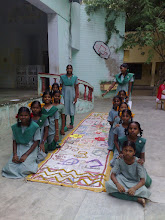The Hindu : Friday Review Chennai : Colourful slice of cultureOnline edition of India's National NewspaperFriday, Aug 07, 2009
Colourful slice of culture

SUGANTHY KRISHNAMACHARI
Music, dance and folk arts… Svanubhava 2009 offered students a complete artistic experience.
PHOTOS: R. Shivaji Rao EXCHANGING MUSICAL IDEAS: Therukoothu performance in full flow
A ten-year old is in a tearing hurry, and has no time to answer my questions.
She’s running off to watch Pt. Birju Maharaj’s Kathak performance, organised as part of Svanubhava, the festival of classical music and dance for students.
I manage to corner Apoorva and Ananya from Pune. They are not students of music or dance, and do not know Tamil either, but this doesn’t seem to pose any difficulties. “Music is not constrained by language barriers,” they aver.
S. Balaji, a student of the Government Music College, and Tilak and Saravanan, former students, say, “Lectures by practising vidwans are extremely useful.”
Petra and Lida, both from the Czech Republic, like the air of informality that characterises Svanubhava.
Students at Kalakshetra.
The relaxed atmosphere helps students to shed their inhibitions and participate in interactive sessions such as Neyveli Santhanagopalan’s lec-dem on Tiruppugazh.Discourse on Tiruppugazh
As always, Santhanagopalan connects with the audience at once with his gently bantering tone, which, however, does not distract from the seriousness of his purpose, which is to popularise Tiruppugazh among youngsters.
The lec-dem begins with a brief introduction to the life of Arunagirinathar, the author of Tiruppugazh.
Santhanagopalan teaches the audience anga talam, and sings a verse in the talam, and the audience keep beat.
What’s more, there’s an unexpected treat waiting — they are given copies of the hymn and they sing along too. While research in the area of music therapy has focussed on the raga aspect, maybe research into the beneficial effects of talas should also be taken up, Santhanagoplan suggests.
What did the audience think of the programme? Ramna and Archana from Kerala have decided to include Tiruppugazh in their Bharatanatyam performances in future.
A section of the auidence.
Ramya Shridhar, a sixth grade student from Chicago, says proudly, “I now know all about anga talam.” Balasubramanian, a first year post-graduate student of music, is lost in admiration of the children who were part of a percussion ensemble. “I am glad Svanubhava had an exclusive tala vadya concert. I hate it when people go out during tani avartanam. Hopefully such programmes will bring about a change in the attitude of future audiences.”
Unnikrishnan’s full bench concert the following day, is a good idea, for the students who, the previous day, heard a tala vadhya concert, now see how different percussion instruments can be used in a concert. The gethu and konnakkol are big hits with the young seekers. Avudayarkoil Subramaniam explains the difficulties that the gethu, a stringed percussion instrument, poses.
S. Karthick says aesthetics are imperative in konnakkol, and it must not be a hindrance to the vocalist. Sukumar and Rajesh, students of the Government Music College, say, “We didn’t know that there is much more to konnakkol than mere routine reciting of jatis. Besides, we had never seen the gethu before.”
In his lecture on how to structure compositions, P.S. Narayanaswamy recalls how Semmangudi’s sangatis would suit the raga bhava and the sahitya. For example, he wouldn’t sing Veena Kuppa Iyer’s Ananda Bhairavi varnam like other tana varnams, but would add spurithams. In structuring compositions, Semmangudi ensured that his sangatis were suitable for all types of voices. That is why his patanthara is popular. He gave different types of embellishments to different kritis in Kharaharpriya. For example, ‘Rama Nee Samanamevaru’ can be sung even by beginners. ‘Chakkani Raja’ is for those with more gnanam. ‘Navasiddhi Petraalum’ has a completely different flavour.
A person in the audience wondered what influence P.S. Narayanaswamy has on his students. A.S. Murali had a pithy answer: “Our guru’s influence is obvious in the way we sing.”
In the discussion on guru sishya paramapara, Padma Subramaniam, Chitra Visweswaran, Kamalakar Rao and O.S. Tyagarajan emphasise that a guru discerns the potential and the limitations of a student and teaches accordingly.The folksy touch
A new addition this year is therukkoothu by Purisai Duraisami Kannappa Thambiran Parambarai Therukoothu Mandram. V.R. Devika gives a brief introduction to the art of therukkoothu. We learn that E.Krishna Iyer even tried to persuade the Music Academy to include therukkoothu in their programmes.
The theme for the day is ‘Panchali Sabatham’ from the Mahabharata. “Panchali Sabatham is usually a six-hour programme in villages, but here we pruned it to 40 minutes,” says Purisai Sambandam. “We have used three viruttams and 15 songs.” Since it is considered inauspicious to end with Panchali’s oath, the programme ends with Dushasana tiring out, when he is unable to disrobe Draupadi.
“There are ten adavus in therukkoothu that involve the use of the legs, but with the songs and the body movements, this number increases. There are jathis in koothu, and we teach the jathis and their adavus,” explains Sambandam.
Neyveli Santhanagopalan.
Ramdharshan, a fourth standard student, and Mokshavati, a fifth standard student, find the koothu lively, but cannot follow the story. “It would help if they told us the story first,” they say.
There is more to come in this year’s Svanubhava. To quote Santhanagoplan, students can look forward to “many more divine experiences from Svanubhava.”
















